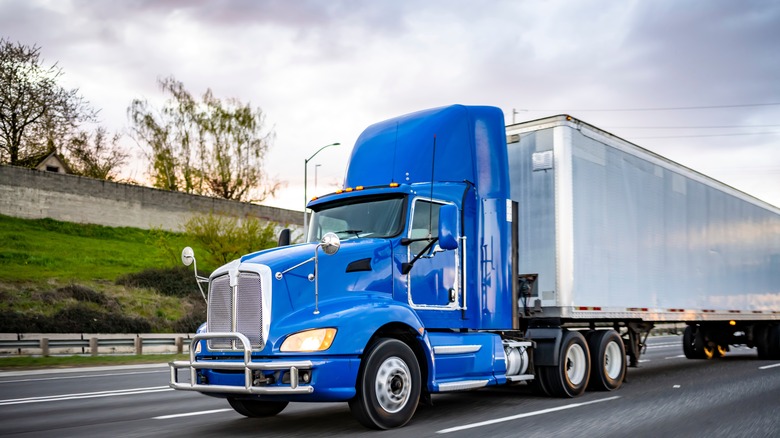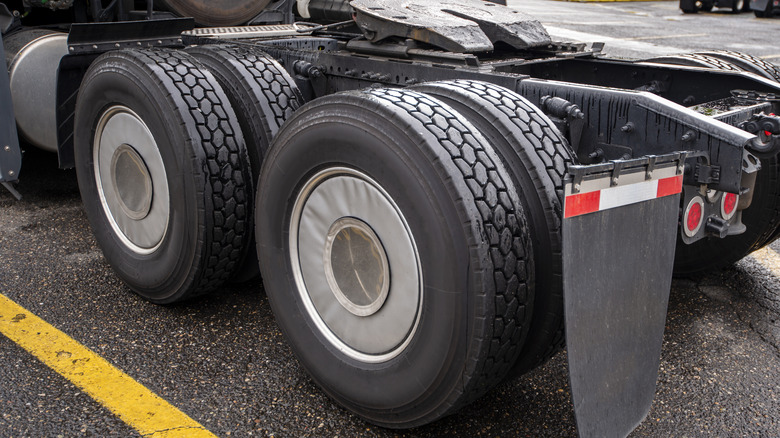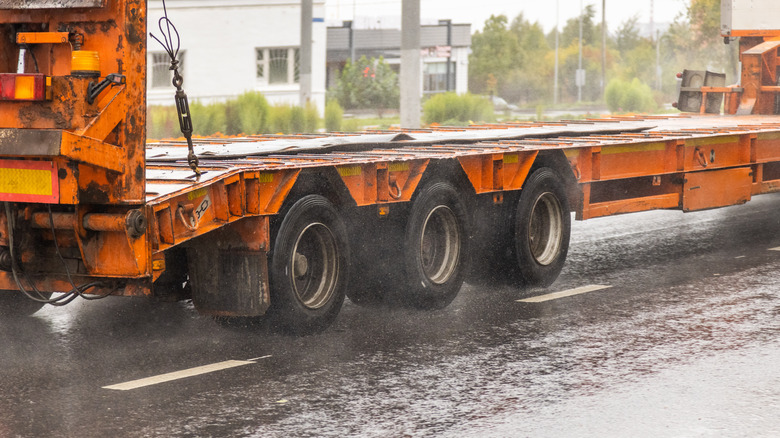Why Do Semi-Trucks Have Rubber Flaps Behind Their Wheels?
When rolling down a long, lonely stretch of highway, have you ever found yourself idly counting the semi trucks as you pass them by? The 18-wheel beasts are the kings of the road, towering over every vehicle in their path while towing cargo by the ton across the interstate. Yet though they serve the same purpose, not all of these trucks have the same features. Some semi-trucks have spiked wheels, which only adds to their commanding presence. Others may not even have a trailer attached, resulting in fewer wheels and a shorter body. But there is one thing all semi-trucks have in common: mud flaps.
Often decorated with a brand logo or the curvy silhouette of a woman striking a pose, the black rubber flaps curtain the rear wheels, whipping behind the semi truck like tiny superhero capes caught on the highway breeze. So, why do all semi trucks have them? Well, for one, mud flaps are mandatory in each state, but it's not for their decorative appeal. Mud flaps may be one of those everyday things you never knew the purpose of. In this case, the purpose they serve is an important one: Protecting wheels and nearby vehicles from debris.
They're not just for mud
If you've ever been caught driving behind a semi-truck, you have those mud flaps in front of you to thank for protecting your windshield. Otherwise, highway debris like rocks, pebbles, and of course mud is bound to get caught in the wheels of the truck and spit out behind it at high speeds, endangering anything in the line of fire. According to a blog post on CarParts.com, mud flaps are in fact necessary, writing: "[Mud flaps] are pivotal in protecting vehicles and pedestrians from potentially dangerous projectiles."
The flaps are especially handy in rainy weather conditions. Because most semi-trailers are equipped with eight wheels, the amount of spray produced from that many tires driving on a rain-soaked road can be dangerous, obscuring the vision of drivers behind the truck. In the more extreme event of a blowout, mud flaps can prevent bits of tire from being flung about the road, reducing the risk of damage to surrounding vehicles.
Of course, as their name suggests, mud flaps are primarily used to combat mud. Shielding against the dirt and grime of the road, the hefty rubber rectangles are useful in keeping semi-trucks cleaner between washes. They can also help prevent rust and protect paint from chips and scratches caused by flying debris, keeping semi-trucks looking better in the long haul.
They're required in each state
Not only are mud flaps necessary, they're mandatory. Unlisted in the safety regulations compiled by the Federal Motor Carrier Safety Administration (FMCSA), there are no federal laws pertaining to mud flaps on semi-trucks. They are, however, required in each state — though the guidelines vary. For example, mud flaps in Texas, Arizona, Delaware, and Missouri must be no further than 8 inches from the ground. Meanwhile, Alaska grants more leeway, requiring mud flaps to hang only 14 inches from the ground.
According to NTEA, most states follow the guidelines of the Society of Automotive Engineers (SAE), which recommends that the width of the mud flap matches the width of the tire and that it falls no more than a ⅓ of the distance from the center of the rear tire to the spot where it's mounted. While it may be hard to keep up with all the different laws — and truck drivers traverse through many different states — a general rule of thumb is that the flaps hang no more than 6 inches off the ground (via U.S. Cargo Control).
Even with all the technical talk, mud flaps aren't just a functional invention — they're good for marketing, too. Think of all the times you've been stuck staring at the back end of a semi-truck. Wouldn't you be inclined to read whatever words your gaze falls upon? Many truck companies capitalized on this notion and began branding their mud flaps with logos and custom information. Now, instead of a curvaceous lady, you may see a phone number or an advertisement for whatever that truck in front of you is hauling. So, the next time you're cruising down the interstate, take note of those flaps flying around you. They're not just for mud.


